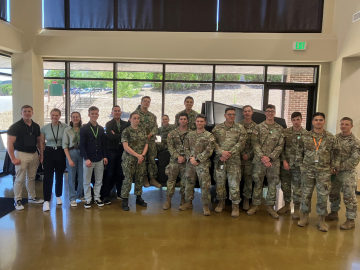
Filter News
Area of Research
- Advanced Manufacturing (7)
- Biology and Environment (45)
- Building Technologies (4)
- Clean Energy (161)
- Computational Biology (1)
- Computer Science (3)
- Electricity and Smart Grid (1)
- Energy Sciences (2)
- Fuel Cycle Science and Technology (1)
- Functional Materials for Energy (2)
- Fusion and Fission (11)
- Fusion Energy (2)
- Isotope Development and Production (1)
- Isotopes (27)
- Materials (88)
- Materials for Computing (15)
- National Security (46)
- Neutron Science (104)
- Nuclear Science and Technology (14)
- Quantum information Science (1)
- Sensors and Controls (1)
- Supercomputing (62)
News Topics
- (-) Buildings (59)
- (-) Energy Storage (111)
- (-) Frontier (44)
- (-) Isotopes (54)
- (-) National Security (68)
- (-) Neutron Science (133)
- (-) Security (24)
- (-) Space Exploration (25)
- (-) Sustainable Energy (129)
- 3-D Printing/Advanced Manufacturing (125)
- Advanced Reactors (34)
- Artificial Intelligence (95)
- Big Data (58)
- Bioenergy (92)
- Biology (100)
- Biomedical (59)
- Biotechnology (23)
- Chemical Sciences (69)
- Clean Water (30)
- Climate Change (103)
- Composites (29)
- Computer Science (194)
- Coronavirus (46)
- Critical Materials (29)
- Cybersecurity (35)
- Decarbonization (81)
- Education (4)
- Element Discovery (1)
- Emergency (2)
- Environment (198)
- Exascale Computing (39)
- Fossil Energy (6)
- Fusion (55)
- Grid (65)
- High-Performance Computing (88)
- Hydropower (11)
- Irradiation (3)
- ITER (7)
- Machine Learning (48)
- Materials (145)
- Materials Science (144)
- Mathematics (9)
- Mercury (12)
- Microelectronics (4)
- Microscopy (51)
- Molten Salt (8)
- Nanotechnology (60)
- Net Zero (14)
- Nuclear Energy (110)
- Partnerships (49)
- Physics (63)
- Polymers (33)
- Quantum Computing (35)
- Quantum Science (70)
- Renewable Energy (2)
- Simulation (49)
- Software (1)
- Statistics (3)
- Summit (59)
- Transformational Challenge Reactor (7)
- Transportation (97)
Media Contacts

A study found that beaches with manmade fortifications recover more slowly from hurricanes than natural beaches, losing more sand and vegetation. The researchers used satellite images and light detection and ranging data, or LIDAR, to measure elevation changes and vegetation coverage. Changes in elevation showed how much sand was depleted during the storm and how much sand returned throughout the following year.

At ORNL, a group of scientists used neutron scattering techniques to investigate a relatively new functional material called a Weyl semimetal. These Weyl fermions move very quickly in a material and can carry electrical charge at room temperature. Scientists think that Weyl semimetals, if used in future electronics, could allow electricity to flow more efficiently and enable more energy-efficient computers and other electronic devices.

The 26th annual National School on Neutron and X-ray Scattering School concluded on August 9, 2024. Each year, more than 200 graduate students in North America studying physics, chemistry, engineering, biological matter and more compete to participate in NXS. However, given limited space, only 60 can be accepted. The school exposes graduate students to neutron and X-ray scattering techniques through lectures, experiments, and tutorials.

Benjamin Manard, an analytical chemist in the Chemical Sciences Division of the Department of Energy’s Oak Ridge National Laboratory, will receive the 2024 Lester W. Strock Award from the Society of Applied Spectroscopy.

Ten future U.S. Army officers recently visited ORNL to learn about the legacy of nuclear science. As students of the Nuclear Science and Engineering Research Center, or NSERC, with the Defense Threat Reduction Agency, or DTRA, they stopped in East Tennessee as part of a larger tour across nuclear facilities supporting the military. In Oak Ridge, they visited ORNL to gain an appreciation of the history of the Manhattan Project and how research at a national lab contributes new materials and electronics for the nuclear industry.

Seven entrepreneurs comprise the next cohort of Innovation Crossroads, a DOE Lab-Embedded Entrepreneurship Program node based at ORNL. The program provides energy-related startup founders from across the nation with access to ORNL’s unique scientific resources and capabilities, as well as connect them with experts, mentors and networks to accelerate their efforts to take their world-changing ideas to the marketplace.

Five researchers at the Department of Energy’s Oak Ridge National Laboratory recently completed an eight-week pilot commercialization coaching program as part of Safari, a program funded by DOE’s Office of Technology Transitions, or OTT, Practices to Accelerate the Commercialization of Technologies, or PACT.

The world’s fastest supercomputer helped researchers simulate synthesizing a material harder and tougher than a diamond — or any other substance on Earth. The study used Frontier to predict the likeliest strategy to synthesize such a material, thought to exist so far only within the interiors of giant exoplanets, or planets beyond our solar system.
Joe Tuccillo, a human geography research scientist, leads the UrbanPop project that uses census data to create synthetic populations. Using a Python software suite called Likeness on ORNL’s high-performance computers, Tuccillo’s team generates a population with individual ‘agents’ designed to represent people that interact with other agents, facilities and services in a simulated neighborhood.

Two ORNL teams recently completed Cohort 18 of Energy I-Corps, an immersive two-month training program where the scientists define their technology’s value propositions, conduct stakeholder discovery interviews and develop viable market pathways.


